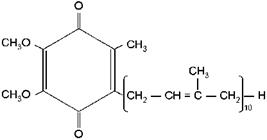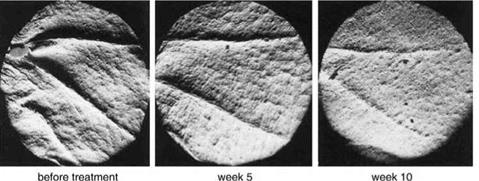The fact that ubiquinone can serve not only as an energy generator but also as an antioxidant in the skin has been investigated (168,169). In cultured human keratinocytes exposed to hydrogen peroxide, the detrimental increase in the activity of phosphotyrosine kinase was suppressed and the loss of glulathione was prevented (169). Ubiquinone (0.3%) also suppressed the UVA-induced reduction of mitochondrial membrane potential in fibroblasts from both young and old human donors (169). Finally, the UV-induced oxidative damage to DNA in keratinocytes in vitro was reduced significantly with ubiquinone (169).
Ubiquinone can retard loss of hyaluronic acid and slowdown of cell division—both manifestations of intrinsic aging. Aged human fibroblasts in vitro produce less glycosaminoglycan and proliferate more slowly than young cells. The addition of ubiquinone increased levels of glycosaminoglycan as well as rates of cell division (169).
Ubiquinone further protects from the UVA-induced degradation of collagen. Both ubiquinone and vitamin E were shown in vitro to suppress fibroblast production of UVA – induced collagenase, thereby markedly retarding collagen breakdown (169). Ubiquinone suppressed collagenase expression over a longer period of time than did vitamin E.
|
Figure 14 The molecular structure of ubiquinone. The “head” of the ubiquinone molecule is a fully substituted quinone ring which does not allow addition reactions with thiol groups in the cell (such as GSH). Ubiquinones vary by the length of the “tail”: Q10 has 10 isoprene units. Humans can synthesize Q10 out of the other coenzymes Q1 to Q9, though this ability decreases with age. |
|
Figure 15 Reduction of wrinkles with ubiquinone. Silicone replicas of the skin, analyzed by laser profilometry, show a significant reduction in the depth of periorbital fine lines and wrinkles in a 46-year-old female after 10 weeks of twice-daily application of ubiquinone cream (Eucerin Q10 Anti-Wrinkle Sensitive Skin Creme). Source: From Ref. 168. |
The concentration of ubiquinone is highest in organs with high rates of metabolism such as heart, kidney, and liver, where it functions as an energy transfer molecule (164). In skin, the level of ubiquinone is relatively low, with 10-fold higher levels in the epidermis than in the dermis (169). Thus, the epidermis might potentially benefit from topical ubiquinone. Indeed it has been demonstrated that ubiquinone can be topically absorbed. Application of ubiquinone in ethanol to porcine skin achieved 20% penetration into the epidermis and 27% into the dermis (169).


